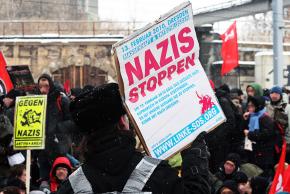Stopping the Nazis in Dresden
Counterprotesters from all over Germany and Europe gathered in Dresden to prevent neo-Nazis from marching. and report.
MORE THAN 10,000 anti-fascists turned out in Dresden, Germany, to protest a yearly gathering on February 13 of neo-Nazis on the anniversary of the 1945 bombing raid that destroyed the city.
Antiracist counterprotesters formed a blockade around the New Town train station where the Nazi demonstration was scheduled to be held, successfully confining the 5,000 far-right demonstrators to a small area for the whole day.
With cries of "¡No Pasarán!" and "Nazis out of our city!" protesters blockaded the streets around the train station to the north, and formed a human chain along the Elbe River to prevent the Nazis from marching into the old city. Over 10,000 people participated in the different sections of the blockade, including Dresden residents and its mayor, activists from the Left Party and the Green Party, anti-fascist activists, trade unionists and students from throughout Germany and Europe.
Activists organized buses from around the country to bring protesters to Dresden. More than 200 buses, including more than 30 from Berlin alone, arrived in Dresden in the early morning to participate in the blockades.

Last year, some 7,000 neo-Nazis marched through Dresden, making it one of the biggest Nazi protests since the Second World War and twice as big as the protest the year before. Left-wing organizers feared that this year, the 65th anniversary of the bombing of Dresden, the demonstration had the potential to be even bigger.
As the German economy stagnates in the midst of the world financial crisis, the far right has found it easier to attract supporters by rallying against social ills like unemployment and the war in Afghanistan. Some parts of rural Germany have already turned into "no-go areas" for immigrants and anti-fascists due to the rising threat of violence from neo-Nazi street gangs.
Dresden, the capitol of neo-Nazi stronghold Saxony, is the site for the annual gathering, which is the highpoint of neo-Nazi mobilization across Germany.
Standing in the snow in temperatures in the mid-20s for over seven hours, protesters were able to stay informed about what was going on in other sections of the city through an Info Radio, set up specifically for blockade purposes, and frequent announcements by organizers.
The neo-Nazis, kept in the direct vicinity of the New Town train station, tried throughout the day to negotiate with police so that they could hold their march. But over and over, the police refused to break up the blockades of counterprotesters in the streets in all directions. There were isolated skirmishes between the two sides, and police employed water canons to break them up; but by and large, the blockades were peaceful.
The city of Dresden tried to have the march banned, but the court had ruled against the ban a day before the protest, arguing that it would have breached the German constitution, which allows the right of public assembly.
When the final decision came through that the Nazis had to leave, cheers went up from the crowds. "We have for the first time succeeded in preventing the biggest neo-Nazi march in Europe," said Lena Roth, a spokeswoman for anti-fascist group Dresden Without Nazis. In the streets, the mood was jubilant, and frequent cries of "We won!" went up from those gathered at the blockades.
"February 13 belongs to the Dresdners again" reported the local Sächsiche Zeitung newspaper. Today, "the city was defined by 10,000 who formed a human chain through the historical center."
The successful blockade is a major loss for Germany's far right and provides newfound confidence to anti-fascists across Germany. Nevertheless, Germany still has an estimated 10,000-plus organized neo-Nazis within its borders, underscoring the need for unified, broad anti-fascist mobilizations in the face of the rising danger of the far right.


